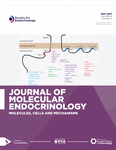RNAs as extracellular signaling molecules
-
Figure 1
Sidt1 and Sidt2 expression in the adult mouse brain. (a) No probe control of adult mouse brain in sagittal section (with detail of hippocampus). (b) In situ hybridization of Sidt1 showing expression in the cerebral cortex, mitral layer of the olfactory bulb, and hippocampus. Close-up image (right) shows heterogenous expression of Sidt1 in the hippocampus. (c) In situ hybridization of Sidt2 showing expression broadly throughout the brain. Close-up image (right) shows specific expression of Sidt2 in the Purkinje cell layer of the cerebellum. Images courtesy of the Allen Brain Atlas (Lein et al. 2007).
-
Figure 2
Schematic showing known and putative extracellular signaling pathways mRNA (blue) and ncRNA (red) are (a) transcribed in the donor cell. These RNAs are then (b) trafficked and packaged into vesicles, which are emitted into (c) the extracellular environment. (d) The vesicles then dock and fuse with the target cell, releasing their RNA content. The mRNA may then be (e) translated in the donor cell and the ncRNA may impart regulatory functions, such as guiding the catalytic function of chromatin modifying proteins (ChM) to mediate (f) epigenetic modifications. In addition (g) extracellular RNA signals, such as siRNAs or miRNAs, may be transferred across the plasma membrane by specific receptors and channels, such as Sid-1. (h) These signals may fulfill regulatory functions in the cell such as translation inhibition or mRNA degradation.
- © 2008 Society for Endocrinology











